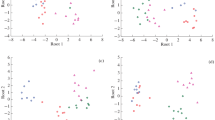Summary
In a variety of tissues of organs3H-(−)-7-,3H-(−)-7,8 and3H-(−)-2,5,6-noradrenaline were compared, partly also with unlabelled (−)-noradrenaline. The following isotope effects were found:
-
1.
Neuronal uptake (vas deferens, rabbit heart): tritium reduced the neuronal uptake by a factor of 1.3 to 2.0 (reduction:3H-7-<3H-7,8-<3H-2,5,6-noradrenaline).
-
2.
Extraneuronal uptake (rat heart): tritium reduced the extraneuronal uptake of noradrenaline by a factor of 1.3 to 1.8 (reduction:3H-7-<3H-7,8-<3H-2,5,6-noradrenaline).
-
3.
Monoamine oxidase (MAO; homogenates of rat heart):3H-7-noradrenaline was a better substrate than was unlabelled noradrenaline, but3H-7,8- and3H-2,5,6-noradrenaline were inferior substrates.
-
4.
Neuronal and extraneuronal deaminating systems: in the intact cells of the rat vas deferens (neuronal deaminating system) or of the rat heart exposed to cocaine (extraneuronal deaminating system) the low rate constant characterizing the deamination of3H-7,8- and3H-2,5,6-noradrenaline resulted in high intracellular concentrations of3H-noradrenaline; consequently, the low rate constant failed to greatly affect steady-state rates of deamination.
-
5.
Catechol-O-methyl transferase (COMT): in rat heart homogenates the rate constant for the O-methylation of3H-noradrenaline was: unlabelled (−)-noradrenaline=3H-(−)-7-noradrenaline>3H-(−)-2,5,6-noradrenaline.
-
6.
Extraneuronal O-methylating system (rat heart exposed to cocaine): steady-state rates of formation of3H-NMN were higher for3H-7- than for3H-7,8-noradrenaline, but an inverse relationship was found for the intracellular accumulation of labelled amine.
It is concluded that tritium has an isotope effect, the magnitude of which depends on its position in the noradrenaline molecule. However, except for the hindrance of dedamination by tritium in position 8, all isotope effects reported here were rather small.
Similar content being viewed by others
Abbreviations
- MAO:
-
monoamine oxidase
- COMT:
-
eatechol-O-methyl transferase
- NMN:
-
normetanephrine
- DOPEG:
-
dihydroxyphenylglycol
- DOMA:
-
dihydroxymandelic acid
- MOPEG:
-
methoxyhydroxyphenylglycol
- VMA:
-
methoxyhydroxymandelic acid
- OMDA:
-
sum of MOPEG+VMA
- OM:
-
sum of NMN+MOPEG+VMA
References
Aronoff S (1958) Techniques of radiobiochemistry. The Iowa State College Press
Axelrod J, Tomchick R (1958) Enzymatic O-methylation of epinephrine and other catechols. J Biol Chem 233:702–705
Belleau B, Burba J (1960) The stereochemistry of the enzymic decarboxylation of amino acids. J Am Chem Soc 82:5751–5752
Belleau B, Fang M, Burba J, Moran J (1960) The absolute optical specificity of monoamine oxidase. J Am Chem Soc 82:5752–5754
Blaschko H, Richter D, Schlossmann H (1937) The oxidation of adrenaline and other amines. Biochem J 31:2187–2196
Bryan LJ, Fleig H, Trendelenburg U (1983) A comparative study of the properties of the catechol-O-methyltransferase inhibitors, U-0521 and tropolone acetamide, in rat perfused heart. Naunyn-Schmiedeberg's Arch Pharmacol 322:6–19
Fiebig ER, Trendelenburg U (1978a) The neuronal and extraneuronal uptake and metabolism of3H-(−)-noradrenaline in the perfused rat heart. Naunyn-Schmiedeberg's Arch Pharmacol 303:21–35
Fiebig ER, Trendelenburg U (1978b) The kinetic constants for the extraneuronal uptake and metabolism of3H-(−)-noradrenaline in the perfused rat heart. Naunyn-Schmiedeberg's Arch Pharmacol 303:37–45
Giachetti A, Shore PA (1966) Optical specificity of monoamine oxidase. Life Sciences 5:1373–1378
Graefe KH (1981) The disposition of3H-(−)-noradrenaline in the perfused cat and rabbit heart. Naunyn-Schmiedeberg's Arch Pharmacol (1981) 318:71–82
Graefe KH, Bönisch H, Fiebig R, Trendelenburg U (1975) Extraneuronal uptake and metabolism of catecholamines in isolated perfused hearts. Proc Sixth Intern Congr Pharmacol Helsinki vol 2:117–130
Graefe KH, Bönisch H, Keller B (1978) Saturation kinetics of the adrenergic neurone uptake system in the perfused rabbit heart. A new method for determination of initial rates of amine uptake. Naunyn-Schmiedeberg's Arch Pharmacol 302:263–273
Henseling M, Trendelenburg U (1978) Stereoselectivity of the accumulation and metabolism of noradrenaline in rabbit aortic strips. Naunyn-Schmiedeberg's Arch Pharmacol 302:195–206
Holzbauer M, Sharman DF (1972) The distribution of catecholamines in vertebrates. In: Blaschko H, Muscholl E (eds) Catecholamines, Handbook of Exp. Pharmacol. Springer, Berlin Heidelberg New York, vol 33:110–185
Iversen LL (1967) The uptake and storage of noradrenaline in sympathetic nerves. Cambridge University Press, Cambridge, England, 253 pages
Keller B, Graefe KH (1979) The inhibitory effect of some monovalent cations on the stimulation by Na+ of the neuronal uptake of noradrenaline. Naunyn-Schmiedeberg's Arch Pharmacol 309: 89–97
Kurahashi K, Rawlow A, Trendelenburg U (1980) A mathematical-model representing the extraneuronal O-methylating system of the perfused rat heart. Naunyn-Schmiedeberg's Arch Pharmacol 311: 17–32
Laverty R, Taylor KM (1968) The fluorometric assay of catecholamines and related compounds: Improvements and extensions to the hydroxyindole technique. Anal Biochem 22:269–279
Lindmar R, Muscholl E (1964) Die Wirkung von Pharmaka auf die Elimination von Noradrenalin aus der Perfusionsflüssigkeit und die Noradrenalinaufnahme in das isolierte Herz. Naunyn-Schmiedebergs Arch Exp Pathol Pharmak 247:469–492
Mack F, Bönisch H (1979) Dissociation constants and lipophilicity of catecholamines and related compounds. Naunyn-Schmiedeberg's Arch Pharmacol 310:1–9
Patil PN, Miller DD, Trendelenburg U (1974) Molecular geometry and adrenergic drug activity. Pharmacol Rev 26:323–392
Starke K, Steppeler A, Zumstein A, Henseling, M, Trendelenburg U (1980) False labelling of comercially available3H-catecholamines? Naunyn-Schmiedeberg's Arch Pharmacol 311:109–112
Trendelenburg U, Bönisch H, Graefe KH, Henseling M (1979) The rate constants for the efflux of metabolites of catecholamines and phenethylamines. Pharmacol Rev 31:179–203
Yu PH, Barclay S, Davis B, Boulton AA (1981) Deuterium isotope effects on the enzymatic oxidative deamination of trace amines. Biochem Pharmacol 30:3089–3094
Author information
Authors and Affiliations
Additional information
This study was supported by the Deutsche Forschungsgemeinschaft (Tr. 96)
On sabbatical leave, supported by the Consejo Nacional de Investigaciones Cientificas y Tecnicas, Buenos Aires
Rights and permissions
About this article
Cite this article
Trendelenburg, U., Stefano, F.J.E. & Grohmann, M. The isotope effect of tritium in3H-noradrenaline. Naunyn-Schmiedeberg's Arch. Pharmacol. 323, 128–140 (1983). https://doi.org/10.1007/BF00634260
Received:
Accepted:
Issue Date:
DOI: https://doi.org/10.1007/BF00634260



